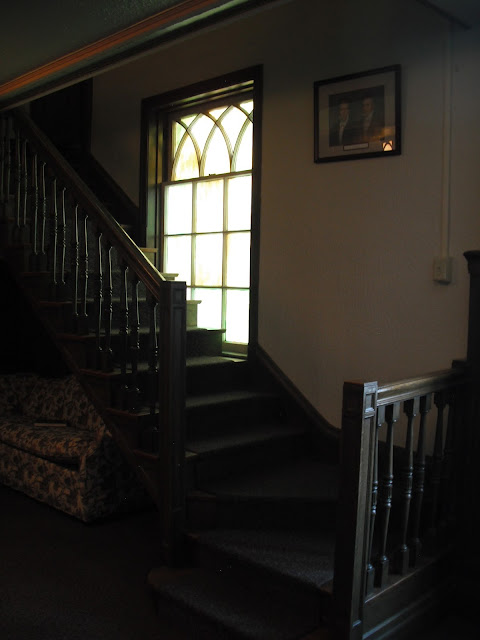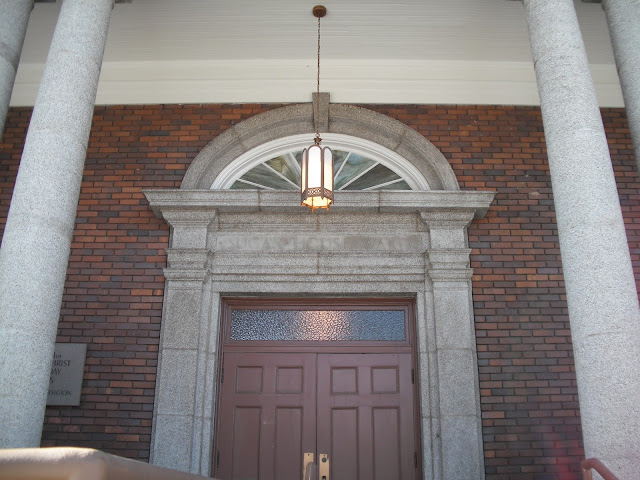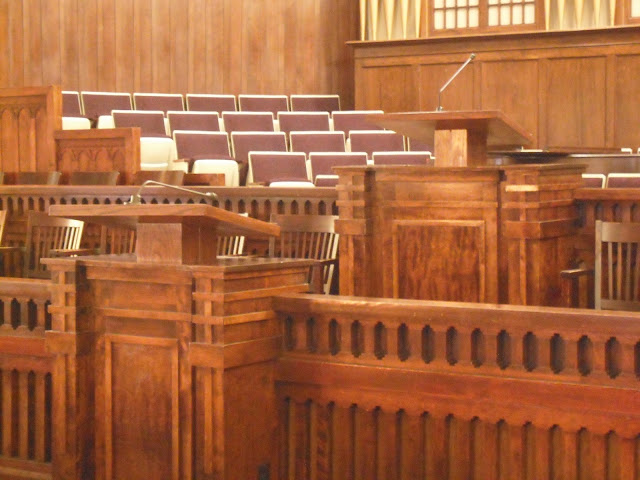The image at the front of the chapel looks like a painting, but it's actually a bas-relief done by the famous Torleif Knaphus. I tried to get a picture of it from an angle so that you can see the depth:
You'll notice that this actually depicts three scenes: the Hill Cumorah on the left, the First Vision in the center, and the Susquehanna River on the right; all important sites in the history of the Church.
It's very well done.
Exploring & documenting historic temples, tabernacles and chapels of the Church of Jesus Christ of Latter-day Saints (also known as the LDS or Mormon Church).
Sunday, February 28, 2016
Thursday, February 25, 2016
Sugarhouse Ward: Interior
Notice how the rostrum is arranged: organ, choir seats, then the pulpit.
These windows lead into a cry room (although now it's just used as a classroom).
Head up the staircase in the lobby and you get to the small balcony at the back.
Tuesday, February 23, 2016
Sugarhouse Ward
Sunday, February 21, 2016
Architecture Highlights: Prayer Circle Rooms in LDS Chapels
Note: The "Architecture Highlights" series focuses on some aspect of LDS architecture that can be found across many chapels. To see all of the posts in this category, click here.
In the past, some of my posts have referenced "prayer circle" rooms in LDS chapels. After some of these posts, I had a few readers reach out to me asking what these were. Because of its sacred nature to Latter-day Saints, I don't encourage readers to search the term on the internet. Instead, I hope to sensitively explain the history of the prayer circle and its place in LDS chapels.
The best definition can be found in the Encyclopedia of Mormonism:
"The prayer circle is a part of Latter-day Saint temple worship, usually associated with the Endowment ceremony. Participants...surround an altar in a circle formation to participate unitedly in prayer."
The prayer circle is an important part of the temple ceremony for Latter-day Saints; however, it used to be performed outside of the ceremony in some instances:
"...some prayer circles were formally organized apart from the Endowment ceremony. Membership in these special prayer circles...did not depend upon Church position. Other prayer circles were formed for priesthood groups: stake presidencies and high councils, priesthood quorums, ward bishoprics-all of them formed under the authority of the First Presidency and generally in response to specific requests." (For more information on the history of the prayer circle, I'd recommend the full entry in the Encyclopedia of Mormonism, or the BYU Studies article on the practice.)
Because of the sacred nature of the prayer circle, which may include an altar, many older LDS chapels had a room that was specifically dedicated for this event. In many cases, these rooms occupy a special place in the building; their location suggests something about their importance.
For example, in the Brigham City Third Ward, the room is accessed by ascending a pair of small staircases behind the pulpit. The room is bathed in colorful light from stained glass windows.
In the Ogden Fourth Ward building (posts will be coming shortly), the prayer circle room is located in the central tower. The room has a high ceiling, an ornate feel, and its own stained glass windows.
In the Clarkston Ward, the prayer circle room is the only room of its size on the same floor of the chapel. Originally, the windows here were beautiful stained glass panels.
The Provo Fourth Ward's prayer circle room is in the main tower. The chapel has since been remodeled into apartments; one of the apartments has access to this beautiful tower room.
There were many other chapels with rooms for prayer circles. The steeple of the tabernacle in Loa, Utah originally contained a room for this purpose; the third floor of the Provo First Ward also had one. Many others, documented or not, existed.
The practice of prayer circles outside of the temple ended in May 1978, when "President Kimball, together with his counselors, instructed leaders to discontinue the practice; the only prayer circles that should be conducted would be those that were part of the temple endowment or part of General Authority meetings" (Ed Kimball, Lengthen Your Stride: The Presidency of Spencer W. Kimball; 375). This may have been a result of several factors: a desire to protect sacred practices as technology evolved, the increased access to temples that came with more temples and better transportation, or a decision that such a practice was not really required. In any case, once the instruction was given to cease the practice, altars were removed, and now these rooms (as can be seen above) serve as classrooms or other areas of space. What's surprising is how quickly knowledge of the practice has faded; most members today express surprise upon hearing that such rooms ever existed.
Whatever its current status, the prayer circle is an important part of the Latter-day Saint heritage. An increased knowledge of this practice can help increase our respect and reverence toward the prayer circle as we participate in it today.
In the past, some of my posts have referenced "prayer circle" rooms in LDS chapels. After some of these posts, I had a few readers reach out to me asking what these were. Because of its sacred nature to Latter-day Saints, I don't encourage readers to search the term on the internet. Instead, I hope to sensitively explain the history of the prayer circle and its place in LDS chapels.
The best definition can be found in the Encyclopedia of Mormonism:
"The prayer circle is a part of Latter-day Saint temple worship, usually associated with the Endowment ceremony. Participants...surround an altar in a circle formation to participate unitedly in prayer."
The prayer circle is an important part of the temple ceremony for Latter-day Saints; however, it used to be performed outside of the ceremony in some instances:
"...some prayer circles were formally organized apart from the Endowment ceremony. Membership in these special prayer circles...did not depend upon Church position. Other prayer circles were formed for priesthood groups: stake presidencies and high councils, priesthood quorums, ward bishoprics-all of them formed under the authority of the First Presidency and generally in response to specific requests." (For more information on the history of the prayer circle, I'd recommend the full entry in the Encyclopedia of Mormonism, or the BYU Studies article on the practice.)
Because of the sacred nature of the prayer circle, which may include an altar, many older LDS chapels had a room that was specifically dedicated for this event. In many cases, these rooms occupy a special place in the building; their location suggests something about their importance.
For example, in the Brigham City Third Ward, the room is accessed by ascending a pair of small staircases behind the pulpit. The room is bathed in colorful light from stained glass windows.
In the Ogden Fourth Ward building (posts will be coming shortly), the prayer circle room is located in the central tower. The room has a high ceiling, an ornate feel, and its own stained glass windows.
In the Clarkston Ward, the prayer circle room is the only room of its size on the same floor of the chapel. Originally, the windows here were beautiful stained glass panels.
The Provo Fourth Ward's prayer circle room is in the main tower. The chapel has since been remodeled into apartments; one of the apartments has access to this beautiful tower room.
 |
| (Image Source: The Old Chapel Apartments) |
The Nibley Park Ward chapel (posts are also coming...I am very backlogged on posts, if you can't tell) also has a prayer circle room in a prominent location--directly above the lobby, right between the chapel and cultural hall. Upon entering the lobby, there is a prominent staircase that takes members up to the second floor, where the prayer circle room used to be located.
There were many other chapels with rooms for prayer circles. The steeple of the tabernacle in Loa, Utah originally contained a room for this purpose; the third floor of the Provo First Ward also had one. Many others, documented or not, existed.
The practice of prayer circles outside of the temple ended in May 1978, when "President Kimball, together with his counselors, instructed leaders to discontinue the practice; the only prayer circles that should be conducted would be those that were part of the temple endowment or part of General Authority meetings" (Ed Kimball, Lengthen Your Stride: The Presidency of Spencer W. Kimball; 375). This may have been a result of several factors: a desire to protect sacred practices as technology evolved, the increased access to temples that came with more temples and better transportation, or a decision that such a practice was not really required. In any case, once the instruction was given to cease the practice, altars were removed, and now these rooms (as can be seen above) serve as classrooms or other areas of space. What's surprising is how quickly knowledge of the practice has faded; most members today express surprise upon hearing that such rooms ever existed.
Whatever its current status, the prayer circle is an important part of the Latter-day Saint heritage. An increased knowledge of this practice can help increase our respect and reverence toward the prayer circle as we participate in it today.
Thursday, February 18, 2016
Tuesday, February 16, 2016
Garland Tabernacle: Interior Details
One of the many unique things about this building: two pulpits. I still haven't been able to find the specific reason for this arrangement.
The organ is a true pipe organ, and it sounds as magnificent as it looks. This building is a real jewel for the Church.
Sunday, February 14, 2016
Garland Tabernacle: Interior
I posted a couple of times on the Garland Tabernacle quite a while ago. Only recently was I able to return and actually get inside. Here is the entryway into the main tabernacle.
A great view awaits:
A balcony stretches across three of the walls, and stained glass lines both sides of the chapel, although additions on the north side mean that those windows don't glow like the other ones. Future posts will provide close-ups of the stained glass and other chapel details.
Thursday, February 11, 2016
Beaver Second Ward: Interior
A few years ago, the Beaver Second Ward chapel was drastically renovated--in fact, basically gutted and then rebuilt, because of the poor condition of the structure.
In the southern part (the original portion, even though it was rebuilt) of the building is now the cultural hall. The chapel used to be in this area.
The chapel has been moved into the northern addition to the building.
Why did the Church bother to extensively remodel the existing building if it was in such bad shape? A ward member told me that it was because of the efforts of a prominent citizen who is a member of the Church. Apparently, the original plan was to tear both original chapels down and build new ones; because of that member's efforts, they were both remodeled. Even so, the historical character has been retained fairly well.
Tuesday, February 9, 2016
Sunday, February 7, 2016
Beaver Second Ward (East Ward)
Built around 1924 (at least that's what the inscription says), the Beaver Second Ward chapel is an elegant building that has undergone a lot of changes.
(Image Source: Church History Library)
From what I can tell, the steeple was added pretty early on, although I still like the look of the building without it.
The building has undergone a lot of changes. I'll post interior pictures soon.
Thursday, February 4, 2016
Kaysville Second Ward (Rock Chapel)
All of Kaysville was in one ward until about 1940, when it was split into 2 wards. The second ward built the rock chapel as their meetinghouse, but it wasn't completed until 1948.
(Image Source: Church History Library)
The chapel houses a magnificent pipe organ. Unfortunately for me, while the building was open, the chapel itself was locked, so I was unable to get in to take pictures. Maybe next time...
The chapel has a courtyard connected to the back, surrounded by a stone fence. There is an old fireplace on one side.
Subscribe to:
Posts (Atom)


















































